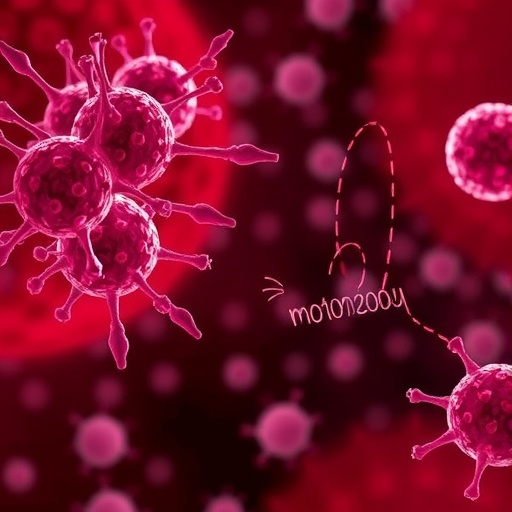In a groundbreaking study led by Yu, S.F. and colleagues, researchers have identified a distinct signature related to amyotrophic lateral sclerosis (ALS) modulation within peripheral blood mononuclear cells (PBMCs). This discovery promises far-reaching implications for our understanding of ALS pathophysiology, as well as advancements in therapeutic strategies and diagnostic approaches. The overarching goal of this research is to illuminate novel pathways and biomarkers that could be pivotal in managing this devastating neurodegenerative disease.
The work conducted by this research team spotlights the intricate relationship between immune responses and neurodegenerative conditions like ALS. By focusing on PBMCs, which play a crucial role in the immune system, the authors have opened new avenues of inquiry into how these cells might influence or reflect neurodegenerative processes. The outcomes of the study indicate that these immune cells do not merely respond to ALS pathology; they may actively participate in the disease’s progression.
At the heart of this study is the understanding that PBMCs can offer a trove of information regarding the physiological state of the body, especially in individuals afflicted by ALS. Researchers extracted and analyzed these cells from patients, employing advanced proteomic techniques to delineate the assembly modulator signature associated with the condition. The findings underscore the potential for PBMC profiling to serve as a window into the dynamics of ALS, enhancing our ability to monitor disease progression and response to therapy.
The implications of identifying an ALS assembly modulator signature in PBMCs extend beyond mere diagnostics. The research suggests that these cellular signatures could serve as potential biomarkers for early detection, enabling timely interventions that could significantly alter the course of the disease. Moreover, the findings raise questions about the possibility of therapeutic strategies targeting PBMCs to modify disease trajectories in ALS.
As the research delves deeper into the molecular mechanisms at play, the authors also propose that changes in the proteomic landscape of PBMCs could reflect broader systemic alterations linked to ALS. Such insights are essential for developing holistic treatment approaches that tackle not only neuronal degeneration but also the immune dysfunctions often accompanying ALS. This comprehensive perspective could lead to integrated therapies that address multiple aspects of disease pathology.
The study’s detailed proteomic analysis yielded a series of proteins and pathways that warrant further exploration. Some proteins identified in the ALS assembly modulator signature are known to be involved in cellular stress responses, neuroinflammation, and apoptosis. These findings suggest that the immune system’s reaction to peripheral signals may be influenced by neurodegenerative factors, thereby enhancing our understanding of ALS as a multifaceted condition influenced by both neuronal and immune dynamics.
The possibility of using PBMC-derived signatures for therapeutic monitoring is particularly exciting. By tracking changes in the assembly modulator signature over time, clinicians may be able to evaluate the effectiveness of ongoing treatments and adjust therapeutic strategies accordingly. This dynamic approach to patient management aligns with the broader trend toward personalized medicine, where therapies are tailored to the specific characteristics of each patient’s disease.
In light of these advances, further research is needed to determine how the insights gained from PBMCs can be translated into clinical practice. The authors highlight the need for larger studies that validate the initial findings and explore the therapeutic potential of targeting PBMCs in ALS. Such investigations could pave the way for innovative treatments that intervene earlier and more effectively than current options.
While the study’s findings are undeniably promising, the authors also emphasize the complexities of the immune system and the challenges in deciphering its role in neurodegenerative diseases. The interaction between immune cells and neuronal environments is intricate, and many variables can affect the progression and presentation of ALS. Therefore, it is crucial for future studies to adopt a multidisciplinary approach, integrating immunology, neurology, and molecular biology to piece together the full picture of ALS pathogenesis.
In conclusion, Yu et al.’s research provides a crucial step forward in the quest to elucidate the mechanisms underlying ALS. By identifying an ALS assembly modulator signature in PBMCs, the study lays the groundwork for future advancements in both diagnostics and therapeutics. This research not only contributes to our understanding of ALS but also underscores the importance of immune system involvement in neurodegenerative diseases, highlighting a path for innovative strategies that could improve patient outcomes. The ongoing exploration of PBMCs as a biomarker source represents a promising frontier in ALS research that could shine a new light on this challenging condition.
In light of the complex interplay between the immune system and neurodegeneration, this study serves as a vital reminder that breakthroughs often emerge from unexpected places. Centralizing the role of PBMCs may provide a more nuanced understanding of ALS, offering both hope and direction for future research and clinical applications. As the landscape of ALS treatment continues to evolve, the insights gleaned from this research may contribute significantly to changing the narrative around this devastating disease.
Subject of Research: Amyotrophic Lateral Sclerosis (ALS) and its relation to peripheral blood mononuclear cells (PBMCs).
Article Title: An ALS assembly modulator signature in peripheral blood mononuclear cells: implications for ALS pathophysiology, therapeutics, and diagnostics.
Article References:
Yu, S.F., Michon, M., Lingappa, A.F. et al. An ALS assembly modulator signature in peripheral blood mononuclear cells: implications for ALS pathophysiology, therapeutics, and diagnostics. Clin Proteom 22, 16 (2025). https://doi.org/10.1186/s12014-025-09538-4
Image Credits: AI Generated
DOI:
Keywords: Amyotrophic Lateral Sclerosis, proteomics, peripheral blood mononuclear cells, biomarkers, immune response, neurodegeneration, diagnostics, therapeutics.




